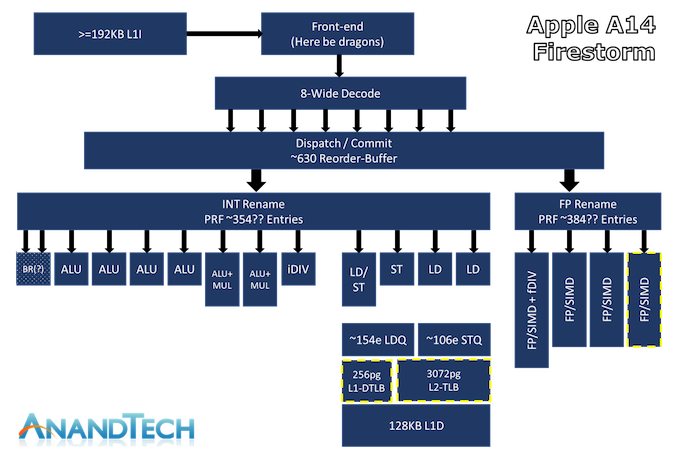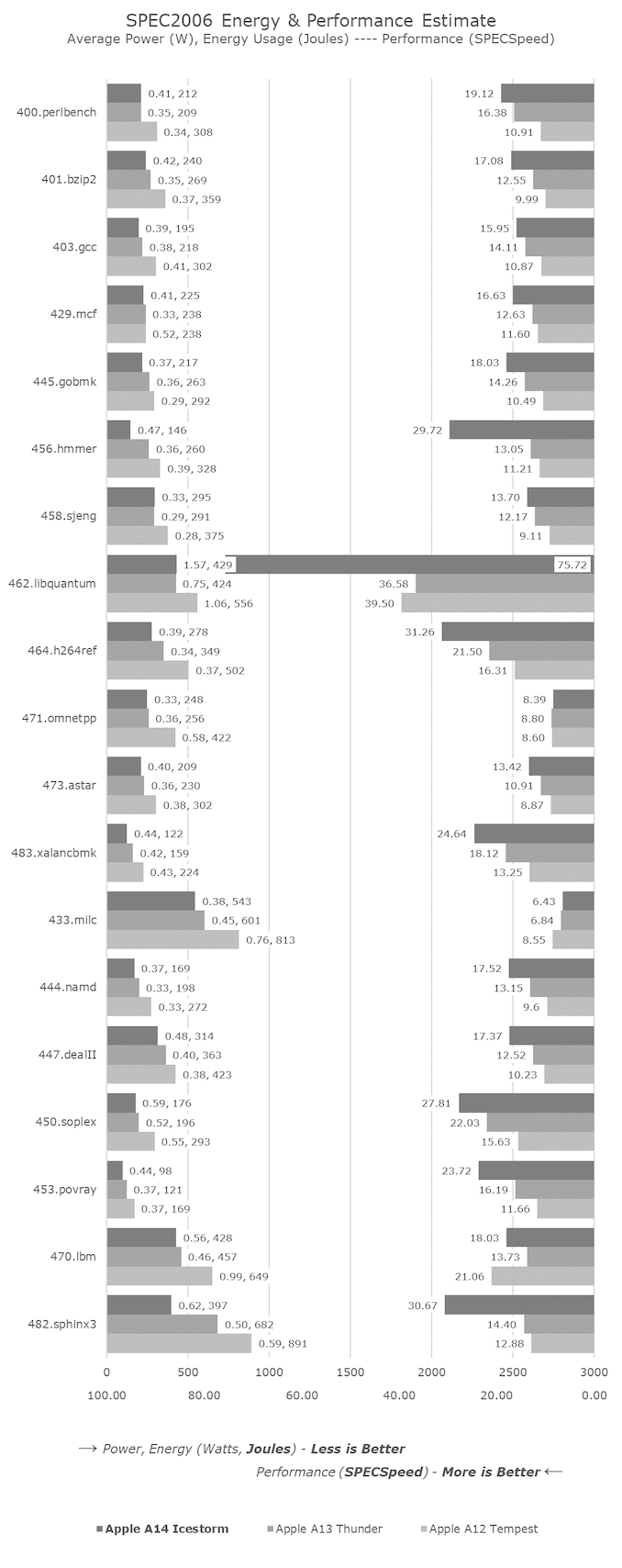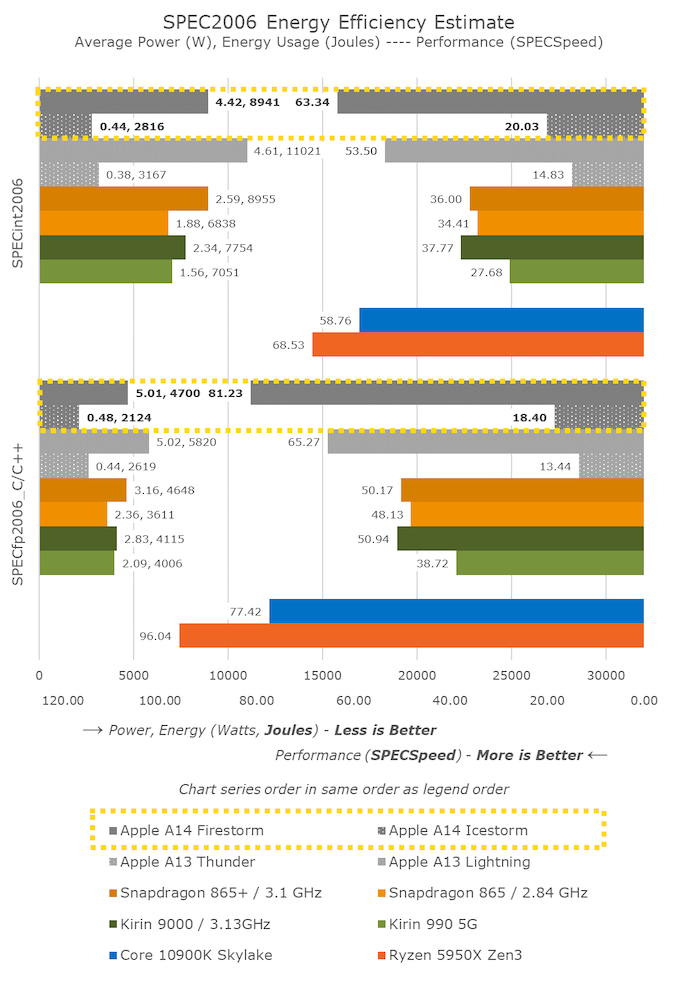The iPhone 12 & 12 Pro Review: New Design and Diminishing Returns
by Andrei Frumusanu on November 30, 2020 8:30 AM EST- Posted in
- Mobile
- Apple
- Smartphones
- Apple A14
- iPhone 12
- iPhone 12 Pro
The Apple A14 SoC: Firestorm & Icestorm
The new Apple A14 is the company’s newest mobile SoC and sits at the heart of the new iPhone 12 series. The new chip is the industry’s first commercial 5nm manufactured chip from TSMC, alongside the now no longer manufactured Kirin 9000.
Inside the A14 we find two big performance cores dubbed “Firestorm” and four efficiency cores called “Icestorm”, making this a 2+4 heterogeneous CPU SoC. Alongside the CPUs, we also find a 4-core GPU. Unfortunately this year it seems like we haven’t seen a public die shot of the A14, though Apple themselves published a shot of the M1 during their announcement event.
| Maximum Frequency vs Loaded Threads Per-Core Maximum MHz |
||||||
| Apple A13 | 1 | 2 | 3 | 4 | 5 | 6 |
| Performance 1 | 2666 | 2590 | 2590 | 2590 | 2590 | 2590 |
| Performance 2 | 2590 | 2590 | 2590 | 2590 | 2590 | |
| Efficiency 1 | 1728 | 1728 | 1728 | 1728 | ||
| Efficiency 2 | 1728 | 1728 | 1728 | |||
| Efficiency 3 | 1728 | 1728 | ||||
| Efficiency 4 | 1728 | |||||
| Apple A14 | 1 | 2 | 3 | 4 | 5 | 6 |
| Performance 1 | 2998 | 2890 | 2890 | 2890 | 2890 | 2890 |
| Performance 2 | 2890 | 2890 | 2890 | 2890 | 2890 | |
| Efficiency 1 | 1823 | 1823 | 1823 | 1823 | ||
| Efficiency 2 | 1823 | 1823 | 1823 | |||
| Efficiency 3 | 1823 | 1823 | ||||
| Efficiency 4 | 1823 | |||||
The new A14 raises the clock speeds of the CPU by a good amount, now essentially reaching 3GHz on the large performance cores in single-threaded scenarios. Once a second big cores come on this reduces to 2.89GHz and stays there even in heavier multi-threaded workloads. The efficiency cores land in at 1823MHz now, roughly a 100MHz boost over the A13, but we do know that in power unconstrained scenarios they can reach quite higher, such as 2064MHz employed on the M1.
The summary is that in this generation, Apple progresses the design further and making it wider than before, increasing the ROB size from 560 to 630, having significantly larger L1 DTLB which has now doubled in size from 128 pages to 256 pages, and increasing the L2 TLB from 2048 pages to 3072 pages. It’s particularly on the part of the floating point and vector execution units where the new Firestorm cores saw most of the design changes this year through the introduction of a 4th pipeline unit, essentially increasing the execution capabilities of this part of the design by 33%. On the integer side of the CPU, things have remained relatively the same with only minor changes, and the Firestorm cores continue on with the sale 192KB L1 I-cache and 128 L1 D-cache and 8MB of shared L2 amongst the two cores.
What we didn’t cover in more detail in the M1 piece was the new small efficiency cores. The Icestorm design is actually a quite major leap for Apple as it sees the introduction of a third integer ALU pipeline, and a full second FP/SIMD pipeline, vastly increasing the execution capabilities of this core. At this point it would be wrong to call it a “small” core anymore as it now essentially matches the big core designs from Arm from a few years ago, being similar in complexity as an A75.
Looking at the generational improvements of the efficiency cores we can see that Apple is indeed showcasing performance increases beyond that of just the increased 100MHz of the cores, with substantial upgrades across the workload spectrum.
Especially the floating-point workloads of the SPEC suite see very large improvements, exactly in the tests which are more execution heavy such as 453.povray or 482.sphinx3.
Apple still continues to limit the absolute performance of the efficiency cores when they are the only allowing the memory controller to not scale up to a higher frequency, meaning that the scores here in isolation are posting worse performance than in a normal more varied real-world scenario where the big CPU cores or the GPU would also be active, hence the scores aren’t directly comparable to other measurements we’ve made.
Overall, the new A14 is massively impressive and grows the performance gap compared to the competition. Apple has now reached higher single-threaded performance within their phone SoCs than what Intel can deliver in any of their designs, whilst only losing out to the desktop variants of AMD’s new Zen3 processors.
What’s important to note here is that Apple’s performance increase this generation did not come at a cost of increased power consumption, as the designers were able to leverage the microarchitectural improvements and the new process node – actually reaching either power parity or a small power reduction compared to the 7nm based A13. This means that the performance increases this generation also results in an energy efficiency increase for the design, with the A14 using notably less energy to complete a workload.
I’ve included the efficiency cores in the chart here to showcase that they’re not weak at all. The performance showcased here roughly matches a 2.2GHz Cortex-A76 which is essentially 4x faster than the performance of any other mobile SoC today which relies on Cortex-A55 cores, all while using roughly the same amount of system power and having 3x the power efficiency.













101 Comments
View All Comments
caribbeanblue - Friday, December 18, 2020 - link
The 2GB extra RAM on the Pro models have shown in a lot of comparison videos I’ve watched on Youtube that they keep more apps open in the background than a standard Android phone with 12GB RAM. But I hope next year we’ll see 6GB in the normal and 8GB RAM in the Pro models, because I have problems keeping apps open in the background with the 4GB RAM in my 11 Pro Max as well.Samus - Wednesday, December 2, 2020 - link
I mean, it’s going in a case anyway, the edges and texture of a phone mean nothing if it’s in a case. Which frankly it should be these are like $1000 investments and everybody eventually drops their phone at some point. I’ve been lucky enough to have never broken one, probably because it’s always in a case and I’m not clumsy enough for it to fall on its screen.crotach - Friday, December 4, 2020 - link
I'm a tall person with massive hands and I prefer flat edged phones :)cha0z_ - Monday, November 30, 2020 - link
The key part here is "mini" - that form factor is totally ok for small phones, but hold the 12 pro max and you can clearly tell it's a lot less comfortable vs the 11 pro max.austinsguitar - Monday, November 30, 2020 - link
the edges are great at the regular and small sizes. just not okay for the huge phones your 4 foot tall girl friend has. you know.rrinker - Monday, November 30, 2020 - link
I've always preferred the square edges older models to the rounder newer ones myself. Seemed like I had better grip and the phone wasn't about to slip out of my hand.RaLX - Monday, November 30, 2020 - link
Exactly, I love the 12 edge, in fact I just went back to iPhones after years using Pixel and Nexus phones partly because I love the "new" old design of flat edges.Devo2007 - Tuesday, December 1, 2020 - link
That’s how I feel about my 12 Pro Max as well. Yes, it’s big, but the flat edges actually provide a better grip for me. I would actually feel comfortable not using a case at least at home with this phone, which I definitely wouldn’t say about the iPhone 11 Pro Max.cha0z_ - Tuesday, December 1, 2020 - link
I am using 11 pro max from over a year naked, never dropped it or had a feeling I don't have a good grip.Cellar Door - Tuesday, December 1, 2020 - link
That is a bit irrelevant - since basically no one uses high end phone with no case these days, unless you get a 10pack of them and don't care if you break one, once a month.